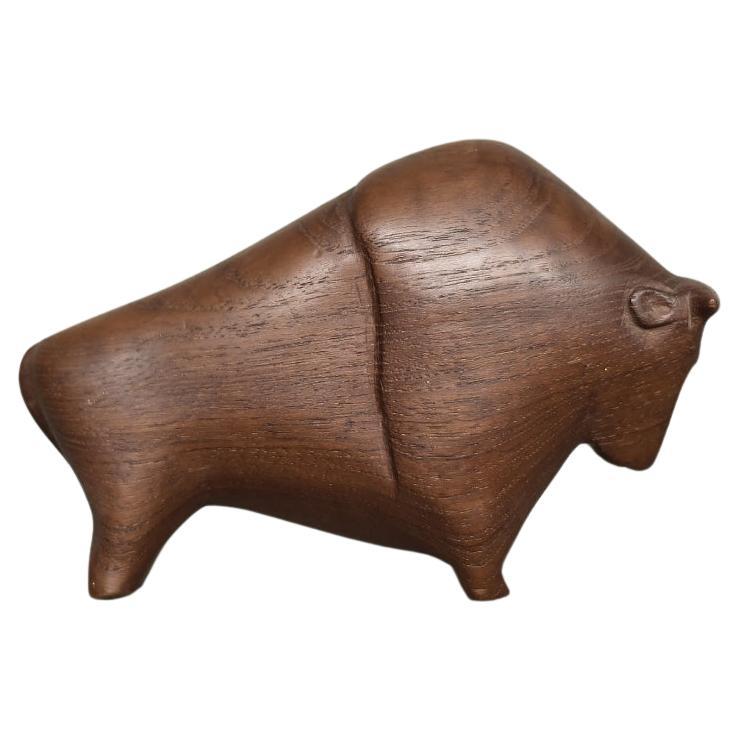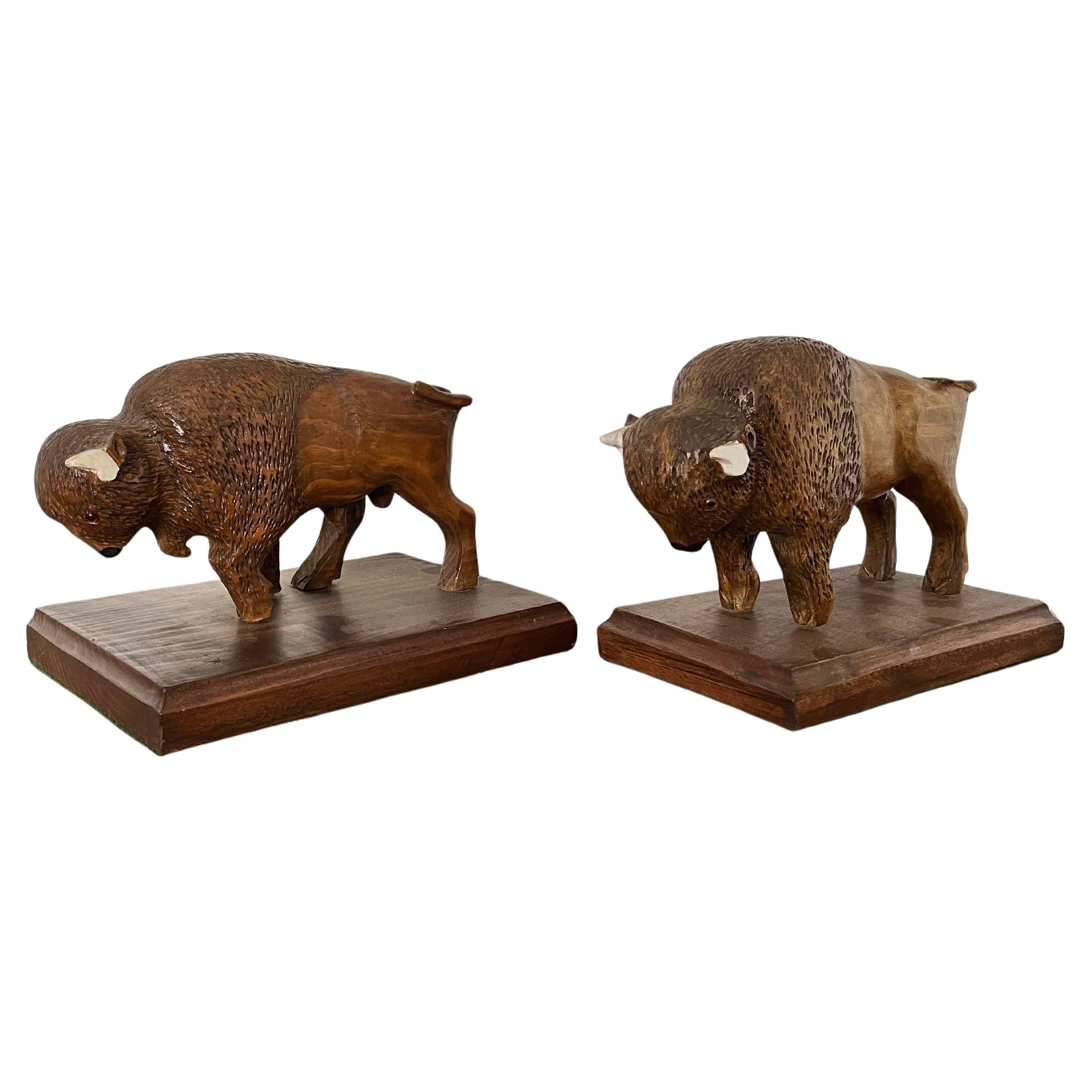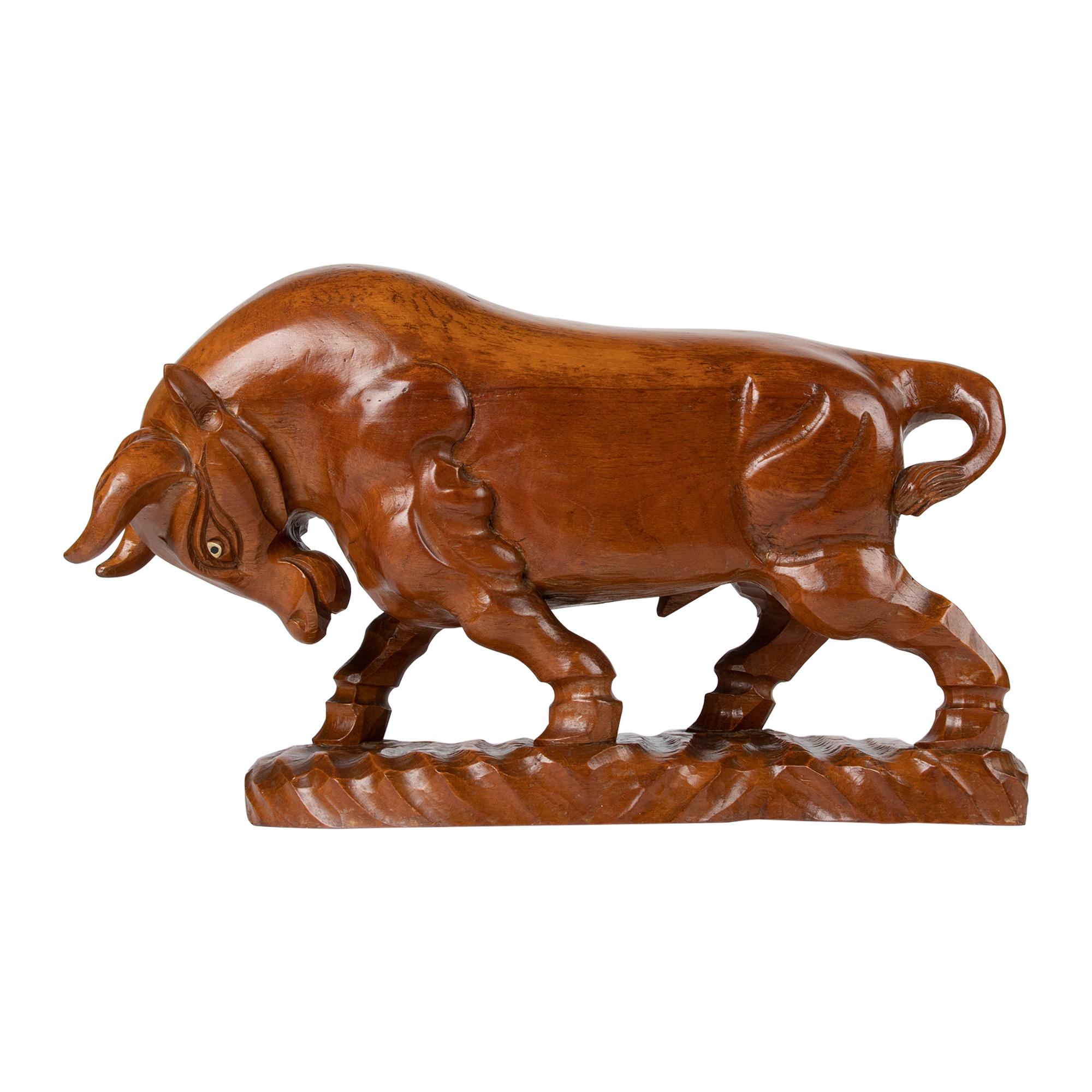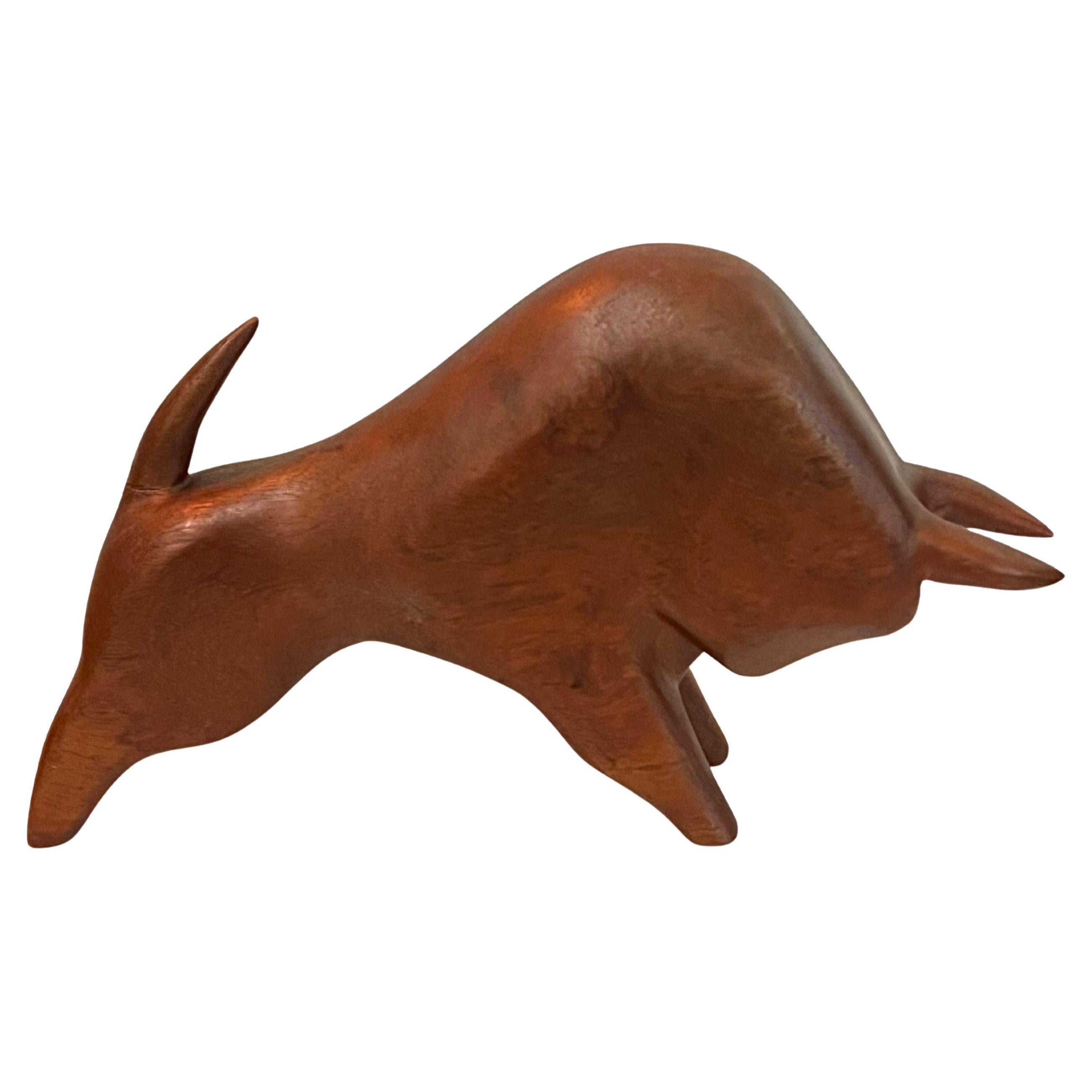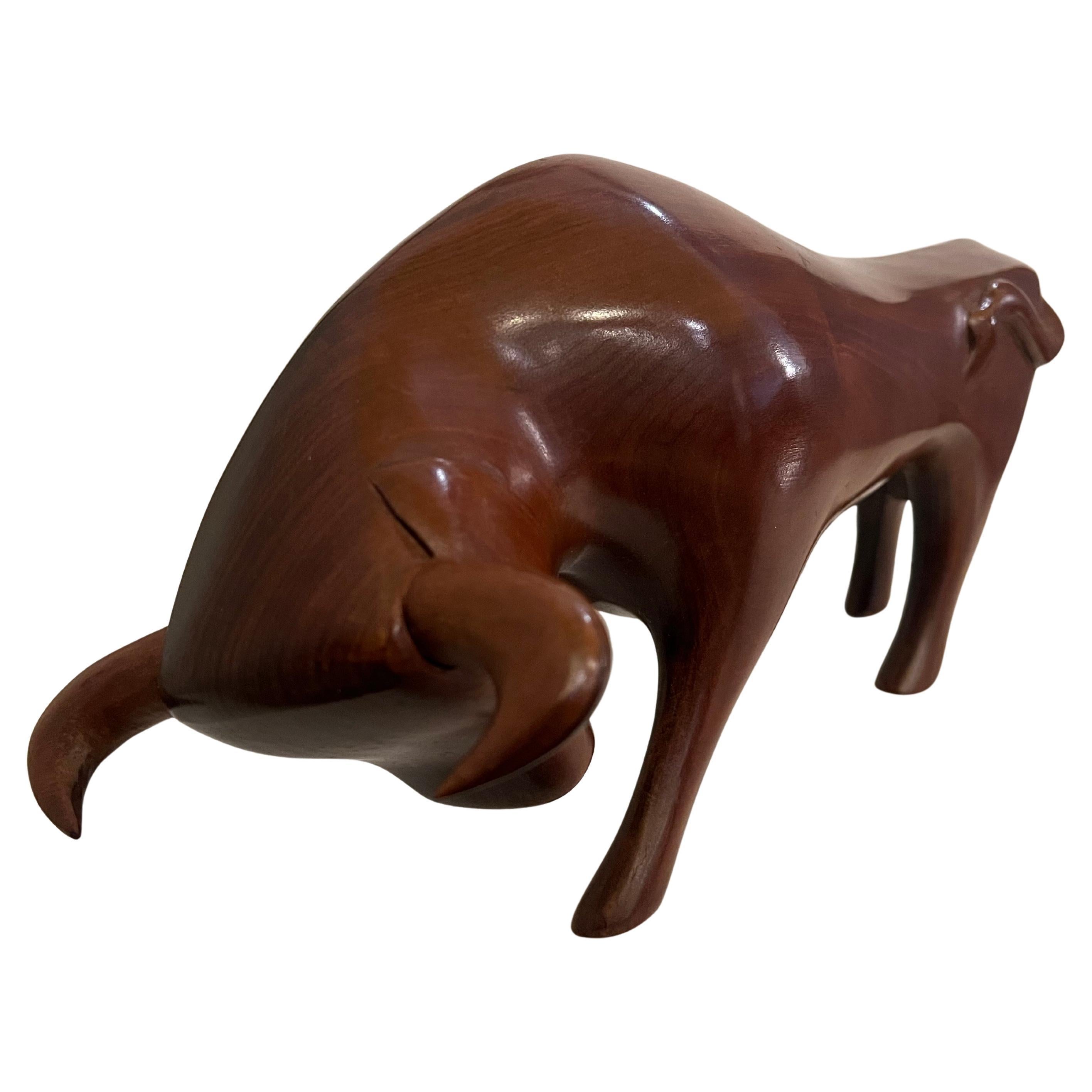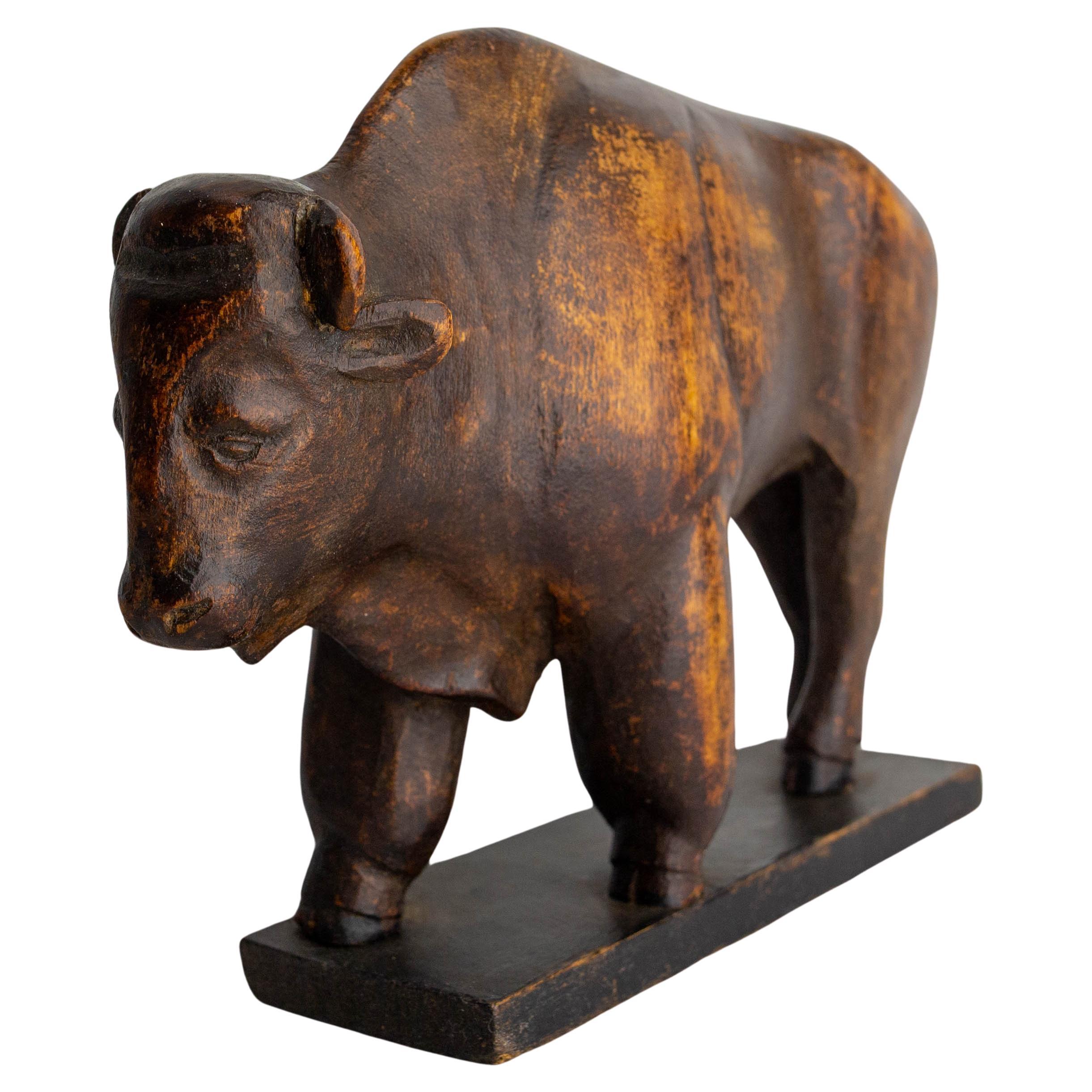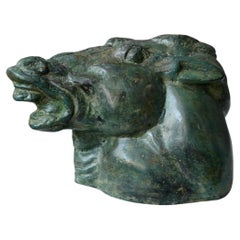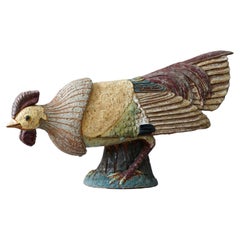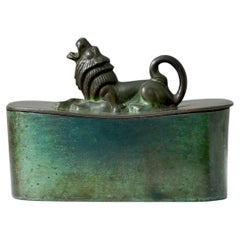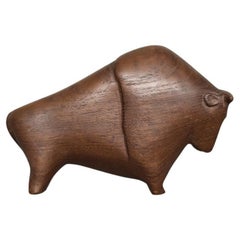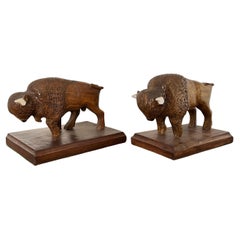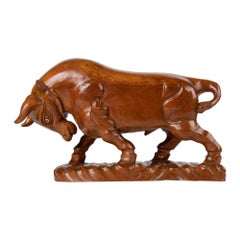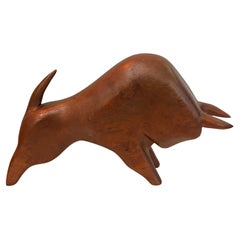Items Similar to Large Danish Mid-Century Carved Teakwood Bison, 1950s.
Want more images or videos?
Request additional images or videos from the seller
1 of 16
Large Danish Mid-Century Carved Teakwood Bison, 1950s.
$3,591.54
£2,671.74
€2,995
CA$4,918.05
A$5,468.20
CHF 2,855.19
MX$66,561.31
NOK 36,431.01
SEK 34,134.12
DKK 22,799.28
Shipping
Retrieving quote...The 1stDibs Promise:
Authenticity Guarantee,
Money-Back Guarantee,
24-Hour Cancellation
About the Item
A stunning Danish mid-century carved teakwood bison.
Reportedly purchased from Den Permanente, Copenhagen, in the early 1950s.
Excellent condition.
Den Permanente was a Co-operative institution for the exhibition of furniture, design and decorative arts and played an important roll promoting the Danish modernist design movement of the 20th century. Founded in 1931 and closed in 1981.
- Creator:Den Permanente (Retailer)
- Similar to:Kay Bojesen (Manufacturer)
- Dimensions:Height: 8.67 in (22 cm)Width: 16.54 in (42 cm)Depth: 5.12 in (13 cm)
- Style:Mid-Century Modern (Of the Period)
- Materials and Techniques:
- Place of Origin:
- Period:
- Date of Manufacture:1950-1955
- Condition:Wear consistent with age and use.
- Seller Location:Malmö, SE
- Reference Number:Seller: 4561stDibs: LU8317241336212
About the Seller
5.0
Platinum Seller
Premium sellers with a 4.7+ rating and 24-hour response times
1stDibs seller since 2023
113 sales on 1stDibs
Typical response time: 1 hour
- ShippingRetrieving quote...Shipping from: Malmö, Sweden
- Return Policy
Authenticity Guarantee
In the unlikely event there’s an issue with an item’s authenticity, contact us within 1 year for a full refund. DetailsMoney-Back Guarantee
If your item is not as described, is damaged in transit, or does not arrive, contact us within 7 days for a full refund. Details24-Hour Cancellation
You have a 24-hour grace period in which to reconsider your purchase, with no questions asked.Vetted Professional Sellers
Our world-class sellers must adhere to strict standards for service and quality, maintaining the integrity of our listings.Price-Match Guarantee
If you find that a seller listed the same item for a lower price elsewhere, we’ll match it.Trusted Global Delivery
Our best-in-class carrier network provides specialized shipping options worldwide, including custom delivery.More From This Seller
View AllCarl Milles Horse's Head Bronze Sculpture
By Carl Milles
Located in Malmö, SE
Carl Milles (1875-1955), after, bronze sculpture of a horse's head. Marked Millesgården.
Great condition.
Born in Uppsala, Sweden, Carl Milles, whose origi...
Category
Vintage 1920s Swedish Art Deco Animal Sculptures
Materials
Bronze
Large and Unique Stoneware Rooster by Tyra Lundgren. Sweden, 1955.
By Tyra Lundgren Carolina
Located in Malmö, SE
A stunning and unique stoneware rooster sculpture with amazing glaze.
Made by Tyra Lundgren. Executed in her own studio in Sweden, 1955.
Great condition, but with a couple of chips to the base (pictured).
Signed by the artist in two places, and dated 1955-06-20.
Provenance: bought from the estate of the artist in 1979.
Tyra Lundgren (1897-1979) was one of the most multifaceted artists and modernists of the twentieth century. She was a painter, drawer, sculptor, ceramist, glass- and textile designer, as well as an author and an art critic. She was the first woman who designed glass for Paolo Venini at Murano in Venice and she also served as the artistic leader at Arabia in Helsinki at a time when men tended to hold those kinds of positions.
Tyra Lundgren grew up in Djursholm, near Stockholm. Her parents were John Petter Lundgren, professor at Veterinärinstitutet (institute of veterinary sciences) in Stockholm, and Edith Lundgren née Åberg, who was a housewife and raised their six children. The bourgeois home also comprised a nanny and a female cook. The family were very socially active, travelled often, and enjoyed the outdoor lifestyle. Tyra Lundgren’s schooling began at Djursholm coeducational school, where her teachers included Natanael and Elsa Beskow and Alice Tegnér. Her school friends included Greta Knutson-Tzara, Stellan Mörner, and Ingrid Rydbeck-Zuhr.
Tyra Lundgren knew from the time she was five years old that she wanted to be an artist. She first became aware of the profession through Axel Fahlcrantz, who rented a studio on the plot of land where she lived with her family. In 1913 she began to attend Högre konstindustriella skolan (HKS, now known as Konstfack, college of arts, crafts and design) where she studied decorative art as well as handicrafts in various forms until 1917. One of her fellow students and friends there was Estrid Ericson, who later founded Svenskt Tenn AB in 1924. Whilst attending HKS Tyra Lundgren also took painting lessons at the Althin school of painting. In 1917 she was accepted as a candidate at the Royal Swedish Academy of Fine Arts where, apart from breaks during which she undertook studies abroad, she remained until 1922. She spent a couple of months taking lessons from Anton Hanak in Vienna and from 1920–1923 she was a student of André Lhote in Paris.
Tyra Lundgren was primarily active in four countries: Sweden, Finland, France, and Italy. She spent much of her professional life travelling and considered herself to be a European. Greece and Mexico also formed important centres in her artistic life, as did the USA. She had an extensive social network which included focal individuals within twentieth century-European and American artistic and cultural circles.
Tyra Lundgren’s main artistic motifs were birds, fish, and people which she depicted through different techniques and materials. Her artistic expression involved a variety of different directions and styles. She was a pioneer of the 1920s Swedish Grace style, the name of which had been coined by the art critic Morton Shand at the Stockholm Exhibition of 1930. This was a Swedish Art Deco style, characterised by elegance and traditional art which contrasted with the current artistic ideals of functionalism.
Tyra Lundgren made her debut at a group exhibition held at Kungliga Akademien för de fria konsterna in 1921. She went on to show her work at various exhibitions throughout the 1920s. After that period she only very rarely exhibited her paintings.
Tyra Lundgren’s painted output can be divided into different periods or stylistic directions. The first of these, and the most extensive, was her post-Cubist period which began in 1920 on her arrival in Paris. Her paintings from this time and right up to the mid-1930s typically comprise portraits, self-portraits, live-model painting, still-lifes, interiors, and landscapes in the Cubist style. Many of the great number of self-portraits she painted were produced in the New Objective style, displaying broad variation in terms of clothes, poses and techniques. Two of these – Huvud med vit duk and Självporträtt both from 1921 – can be seen at Moderna Museet in Stockholm, although the majority of these works are at Gotlands Museum.
Tyra Lundgren’s second artistic period comprises the years of 1927 to 1929 and is characterised by the New Objective style inspired by medieval techniques and materials (Giotto, Piero della Francesca). Her motifs were still-lifes and landscapes. At this point she was living in Rome and was close to the circle involved in the Valori plastici: rivista d’arte art journal. This period saw a breakthrough in her development as a painter. From the 1950s through the 1970s her work can almost be described as belonging to the Concrete style. Using light pastel colours her paintings sought light in a sometimes non-figurative expression, but often depicting abstract bird-shapes or other nature-inspired imagery. Her paintings from this period are outsized and display powerful colours, in yellows, reds, and blues.
Tyra Lundgren maintained a constant production of drawings, both in terms of individual artworks and sketches for patterns and designs. She also produced the illustrations for her book Fagert i Fide. Årstiderna på en gammal gotlandsgård, published in 1961. During her early years she also produced advertising illustrations. She spent the final years of her life primarily working with lithographs which were printed at Galleri Prisma and depicted images of doves, swallows, magpies and crows.
Tyra Lundgren is meanwhile best known for her work as a ceramist and in this sphere she was one of Sweden’s leading exponents. She worked in the porcelain industry as a designer and as an artisan and ceramic sculptor. Her first job was at St Eriks Lervarufabrik in Uppsala from 1922–1924, she then worked at Arabia from 1924–1937, and at Rörstrand and Lidköping Porslinsfabrik. She was the artistic leader at Arabia ahead of the 1930 Stockholm Exhibition and she exhibited her work at the World’s Fairs. During the 1934–1938 period she was connected to the Manufacture nationale de Sèvres porcelain factory in Paris.
Tyra Lundgren was a pioneer when it came to giving ceramic art a public space in Sweden. She produced around 20 outsized reliefs in stoneware, so-called monumental reliefs. One of these is Märkeskvinnor, from 1947, for the former girls’ school at Bohusgatan in Stockholm. From the 1940s onwards Tyra Lundgren produced sculptural objects in Chamotte clay and stoneware, with various glazings. Her small birds are well-known and popular with many. When her ceramic efforts became too much for her during the 1970s she then produced models for sculptures in bronze. There are six of these in various places around the globe, including Solfågel in Almedalen, Visby.
Tyra Lundgren began to work as a glassware designer at Moser in Karlsbad in 1922 where she designed new table services and modernised older ones. She also worked freelance for Riihimäki factory in Finland during the 1924–1929 period. From 1934 to 1938 she was employed by Kosta glass factory where she mainly designed thick-walled bowls and vases, engraved with classical motifs. She was introduced to the glassmaker Paolo Venini at Murano during the Triennale di Milano of 1936 and they began a collaboration that lasted into the 1950s. As part of this collaboration Tyra Lundgren became the first woman to design glassware and, in conjunction with the glassblower Arturo Biasutto, she developed new techniques of glass production. Her motifs at this point were birds, fish, snail-shaped designs and leaf-patterned bowls using traditional techniques as well as in new designs. It was during this time that she created the so-called tissue-shaped bowls and it remains unclear as to who specifically came up with the design but Tyra Lundgren claimed it was of her making.
Tyra Lundgren was active as textile designer for Licium (now HV Licium), the sacred textiles...
Category
Mid-20th Century Swedish Scandinavian Modern Animal Sculptures
Materials
Ceramic, Stoneware
Stoneware Fish Sculpture by Carl-Harry Stalhane, Sweden, 1970s
By Carl-Harry Stålhane
Located in Malmö, SE
A rare and beautiful stoneware fish sculpture with amazing glaze, on a wooden base. Made by Carl-Harry Stålhane in his own studio in Lidköping, Sweden, 1970s.
Excellent condition. S...
Category
Mid-20th Century Swedish Mid-Century Modern Animal Sculptures
Materials
Stoneware, Wood
Art Deco Lidded Bronze Box by GAB Guldsmedsaktiebolaget, Sweden, 1930s
By Just Andersen, GAB Guldsmedsaktiebolaget, Sune Bäckström
Located in Malmö, SE
A beautiful lidded bronze box with amazing patina. Art Deco / Swedish Grace.
Made by GAB Guldsmedsaktiebolaget, Sweden, 1930s.
Good condition, but with scratches and wear to the ...
Category
Vintage 1930s Swedish Scandinavian Modern Decorative Boxes
Materials
Bronze
Large Brown Stoneware Floor Vase by Carl-Harry Stalhane, Rorstrand, Sweden 1960s
By Carl-Harry Stålhane, Rörstrand, rorstrand studio
Located in Malmö, SE
A large and rare stoneware vase with amazing glaze.
Made by Carl-Harry Stålhane at Rörstrand Ateljé, Sweden, 1960s.
Great condition.
Signed 'CHS' and makers mark 'R' with three cro...
Category
Mid-20th Century Swedish Mid-Century Modern Vases
Materials
Ceramic, Stoneware
Brown Stoneware Miniature Vase by Berndt Friberg. Gustavsberg Studio Sweden 1956
By Stig Lindberg, Gustavsberg, Gunnar Nylund, Wilhelm Kage, Berndt Friberg
Located in Malmö, SE
A beautiful miniature stoneware vase with amazing light brown hare’s fur glaze.
Made by master thrower Berndt Friberg, in the artist's studio at Gustavsberg, Sweden, 1956.
Great con...
Category
Mid-20th Century Swedish Scandinavian Modern Vases
Materials
Ceramic, Stoneware
You May Also Like
Vintage Danish Dark Teak Bison Figurine, 1960s
Located in Warszawa, Mazowieckie
This wooden figurine of a Bison was made in Denmark during the 1960s. Hand-made of high-quality teak wood with clearly visible grain. The minimalist form with simplified details refl...
Category
Vintage 1960s Danish Mid-Century Modern Animal Sculptures
Materials
Teak
Vintage Carved Buffalo or Bison Sculpture S.L. Mitchell
Located in W Allenhurst, NJ
Fantastic pair of hand carved wooded buffalo or bison. Great detail and proportions. Slightly different in size. Signed SL Mitchell
Category
20th Century Unknown Mid-Century Modern Animal Sculptures
Materials
Wood
Mid 20th Century Spanish Modern Wooden Sculpture of a Bull
Located in Casteren, Noord-Brabant
Large and impressive wooden sculpture of a bull.
Probably made in Spain, around 1960.
Category
Vintage 1960s Spanish Mid-Century Modern Animal Sculptures
Materials
Wood
American Mid century Modern Solid Mahogany Bull Sculpture Wood Carved
Located in San Diego, CA
Beautiful solid mahogany bull sculpture circa 1960's well done piece , in a mid century design lines simple elegant and unique.
Category
20th Century American Mid-Century Modern Animal Sculptures
Materials
Mahogany
Beautiful Solid Walnut Large Hand Carved Bull Sculpture
By (after) Pablo Picasso
Located in San Diego, CA
Beautiful solid walnut hand carved bull sculpture , circa 1970's excellent condition beautiful piece nice soft finish great detail , nice size.
Category
20th Century American Mid-Century Modern Animal Sculptures
Materials
Walnut
French Wood Buffalo Statuette circa 1940
Located in Labrit, Landes
French handmade wood statue in white wood.
Good condition and nice patina
Shipping:
8,5 / 20 / 15,5 cm 0,3 Kg.
Category
Early 20th Century French Mid-Century Modern Animal Sculptures
Materials
Wood
